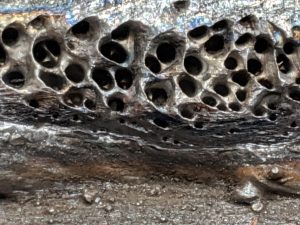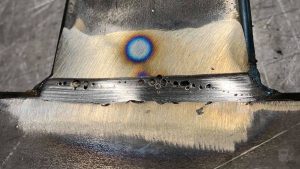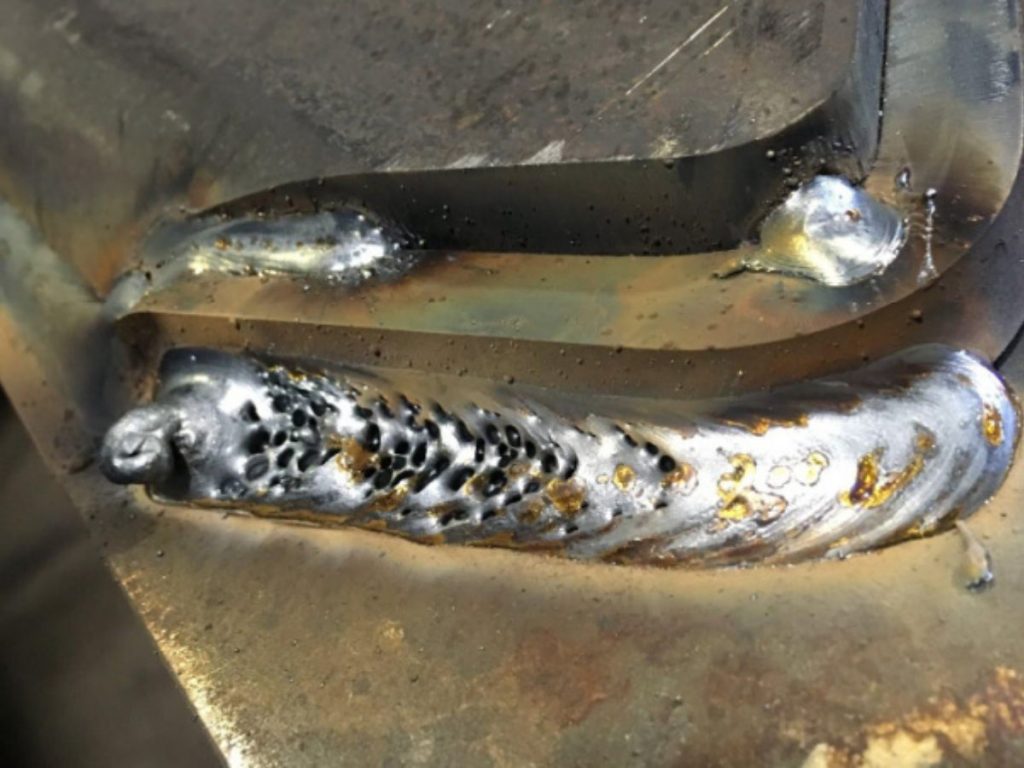Porosity is an unfortunate but common phenomenon that can occur when mig welding. It is a sign that a weld has lost its structural integrity and must be redone before applying force to it. While some welders may try to burn through the porosity, this is not recommended because it can result in other problems. Instead, most experts recommend grinding it off.
What is Welding Porosity?
Porosity in a weld can be caused by a number of things, from base metal contamination to the use of poor welding techniques. It is important to remove porosity as early as possible and repair it before you reweld. There are many different ways to repair porosity.
The first step is to determine the type of porosity. There are two types of porosity: surface-breaking and distributed. Surface-breaking porosity is characterized by holes in the weld surface. Stainless steel and aluminum present different challenges to welding, but both can show evidence of porosity.
Welding porosity can also be caused by improper application of shielding gas. A properly used shielding gas can resolve the problem. However, it is important to understand how to apply it. If it is not properly applied, the gas can contaminate the weld. It is also important to remember that an empty cylinder produces no shielding gas.

In the field of mig welding, there are several types of porosity. Some are internal, while others are external. Both types of porosity result from metal contamination. Depending on the situation, you might need to use x-ray testing to identify the cause.
Some of the main causes of porosity are: a damaged o-ring seal on the wire process; a defective gas solenoid at the wire feeder; or improperly maintained welding equipment. Some other causes include improper weld positions or the improper use of anti-spatter compounds. In addition, welders are prone to developing porosity when their gloves come into contact with the welding arc. A poor weld quality can also be the result of a faulty gun assembly.
Regardless of the cause, porosity in mig welding is a problem to be avoided. It can be prevented by carefully monitoring the welding process. Knowing the causes of porosity can help you implement solutions that will improve quality and reduce downtime. This can make it easier to move parts through the production line and improve your arc-on time.
Why does porosity form?
Porosity in a mig weld can be caused by several factors. Firstly, welders should ensure that the welding gun and electrodes are clean before using them. This is because debris from the welding gun can cause porosity in the weld puddle. Another possible cause of porosity is improper wire tension. If this happens, extra wire may land on the weld puddle before it freezes. To avoid this issue, welders should maintain a steady welding process and not rush the weld. Also, shielding gas must be used properly in order to prevent contaminating atmosphere from getting into the weld puddle.
Another common cause of porosity is faulty gas cylinders and hoses. Check these to ensure they are not damaged by gas leaks or contamination. Another possible cause of porosity is an undercut, which appears as a narrow groove on the base metal adjacent to the weld metal. This groove can act as a stress raiser during fatigue loading.
How to Prevent Porosity
Porosity is a problem that many welders face. It is a type of imperfection that causes the weld to lack structural integrity and requires redoing before exerting any force. Porosity may appear for many reasons, but some are preventable. To reduce porosity in mig welding, welders should avoid certain situations and adhere to best practices.
While a carbon-arc gouge or grinding can correct a bad weld, prevention is always better than cure. A good practice is to sweat the joint before welding to eliminate moisture. This should be done on both the joint members and in the potential heat-affected zone.
Another way to avoid porosity is to make sure that you use the right gas. Gas can introduce porosity in a TIG welder if it is applied improperly. It is vital that a welder understands how to apply shielding gas in order to avoid porosity. Ensure that you use a shielding gas cylinder that is at the correct pressure and flow rate.

Additional Prevention Techniques
Porosity can occur in mig welds due to a variety of reasons. Some of these factors include improper welding gas shielding, impurities on the weld piece, and a high CO2 gas mix. Regardless of the cause, there are several additional prevention techniques that can reduce the amount of porosity in your welds.
The first step to preventing porosity is to ensure the cleanliness of the weld zone. It is important to avoid contamination at the weld site or on the base metal. Another way to prevent porosity is to control the flow of air in the weld zone. Make sure that the welding area is free from drafts and avoid open doors or any machinery that can draft air. The final step is to position your welding equipment in an area that has adequate ventilation.
The second step is to make sure that the wire is properly polarized and has adequate tension. While welding with high voltage can make the process feel smooth, it can also cause porosity. A better way to prevent porosity is to lower the voltage. Another solution is to use a larger diameter wire. A larger wire diameter will reduce the amount of porosity and help you achieve a better deposition rate.
What are the Outcomes of Porosity?
Porosity in welds can cause a variety of problems. The main issue is how to prevent it. The best way to do this is to apply solutions that focus on the type of porosity that you are experiencing. For example, if you have a lot of crater pipe porosity, you should avoid using shielding gas for the weld. This will allow oxygen and nitrogen to get trapped in the weld and cause oxidation.
Porosity is a problem that many welders face. In most cases, porosity is caused by contamination of the metal. However, there are times when the metal is not properly welded. In these cases, welders may have to redo the weld to ensure structural integrity. In addition, some welders may try to “burn” through the porosity, but this method is risky and can cause other problems. Instead, most experts recommend grinding off the porosity before welding.
The outcomes of porosity analysis vary significantly for different welds. One method involves measuring the area fraction of the pores in cross-sections that are transverse to the welding direction. In other tests, longitudinal cross-sections were used to confirm that the transverse images were representative of the fusion zone. The results of these tests show a high correlation between transverse and longitudinal cross-section images.
Conclusion
The presence of porosity in a mig weld may be an indicator of a number of factors. This includes improper weld preparation, damaged o-ring seals on welding guns, and a defective gas solenoid at the wire feeder. Additionally, improper care of welding equipment and the overuse of anti-spatter compounds may lead to porosity. Regardless of the cause, porosity in a mig weld can be prevented by taking several measures.
The first step in eliminating porosity is to ensure that the welding gas is adequate. An inadequate shielding gas is often a major culprit in this problem. Other factors that may cause porosity include improperly extended wire length, dirty base metal, and inadequately sealed shielding gas channels. Air currents generated by cooling fans may also disrupt the shielding gas envelope. In addition, a loose fitting gas channel may allow air to enter the gas flow.
Another common cause of porosity is a crater hole in the weld, which is a small to medium-sized hole created by the weld pool failing to completely fill. This hole requires a careful repair to avoid further deterioration.

